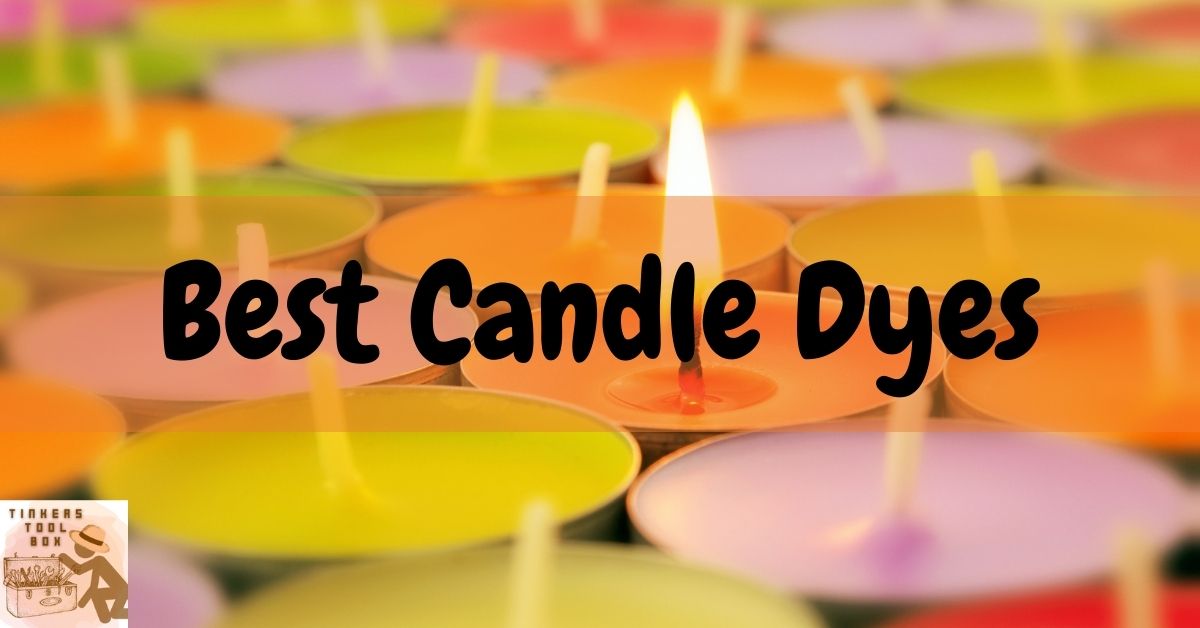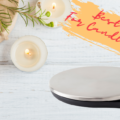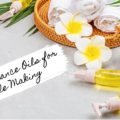Candle-making is a science where you would need trial and error to get the perfect candle that you want. If you want to get the best color possible for your candle, you would need the right candle dyes. There are different candle dyes in the market that will fit your needs when it comes to making your candles, and I will list them all here for you.
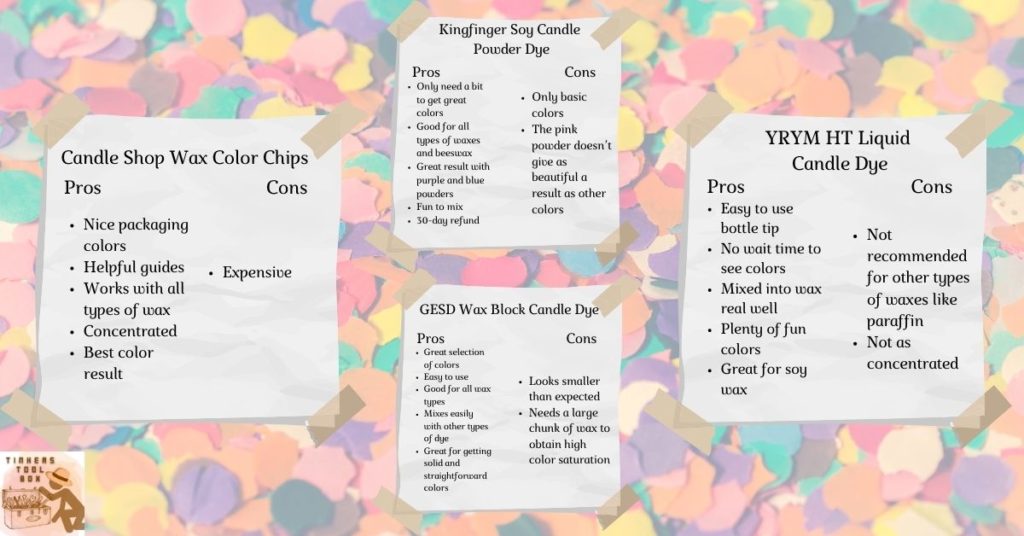
Candle Shop Wax Color Chips: Comes With Great Colors
When it comes to a wide range of great colors, the Candle Shop Wax Color Chips is the best option for you. They come in 0.64-ounce baggies and boast 16 vibrant colors that are perfect for your candle-making projects. They are also vegan, cruelty-free, and non-skin staining, which is a plus, so you don’t have to worry about dirty fingers while making candles.
They work on all types of wax, and the manufacturer also provides visual guides as to what the colors look like paraffin, soy, and palm wax on their website. These wax dye flakes are completely soluble, don’t flake off or tarnish over time, and do not clot.
Now, when it comes to using this dye on soy wax, the dosage depends on the content of fat, hardness, and purity of the candle mass. If you want detailed dosage instructions, you can look them up in the enclosed reference booklet that comes with the product.
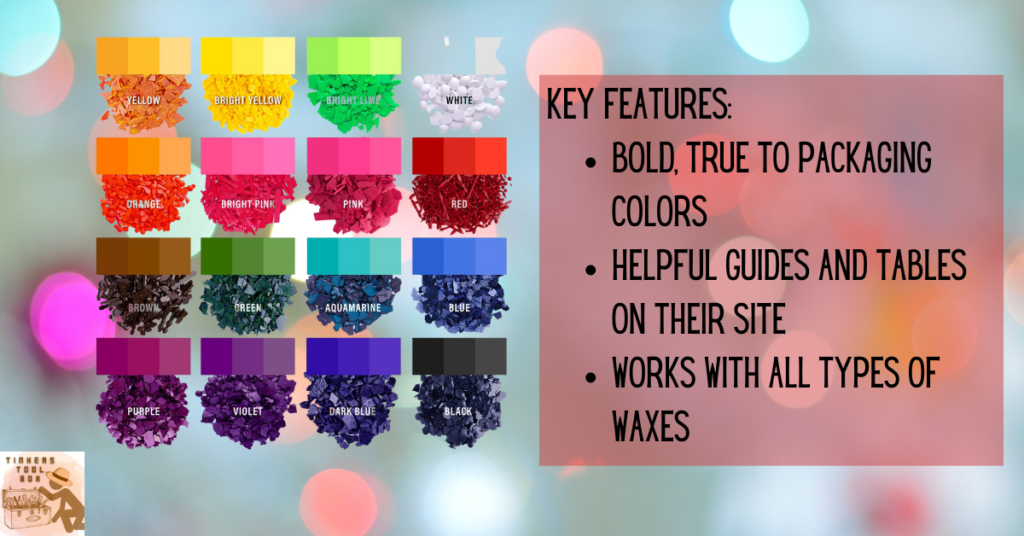
You should take into account that the initial color of the wax you are using since when it is mixed with these color chips, the resulting color of candles may not be what you expect. Always try to test it out with a small amount, and then you can decide if you want to continue with that particular color.
The Candle Shop Wax Color Chips are extremely concentrated, which means all you need is a small amount of dye to achieve the bright colors that you need. For one pound wax, you only need about 0.02 to 0.05 ounces of dye.
The dyes are also easy to crush into small pieces that will allow you to mix them with other dyes. You would do this when you want beautiful shades and colors for your candles. As mentioned above, there is a guide included in each product box that has a detailed table on mixing colors.
You will get beautiful pastel shades when you mix the Candle Shop Wax Color Chips with soy wax. With paraffin, you will get stunning vivid colors, and with palm wax, you will get magical frosty patterns.
Candle Shop is a company that creates high-quality candle dyes for your candle-making needs. The dyes are made from animal-friendly, cruelty-free, irritant and stain-free, and gentle on the skin.
The only downside to the Candle Shop Wax Color Chips is it is a bit expensive.
You can purchase Candle Shop Wax Color Chips on Amazon for $34.99.
Kingfinger Soy Candle: The Best Powder Dye You Can Use
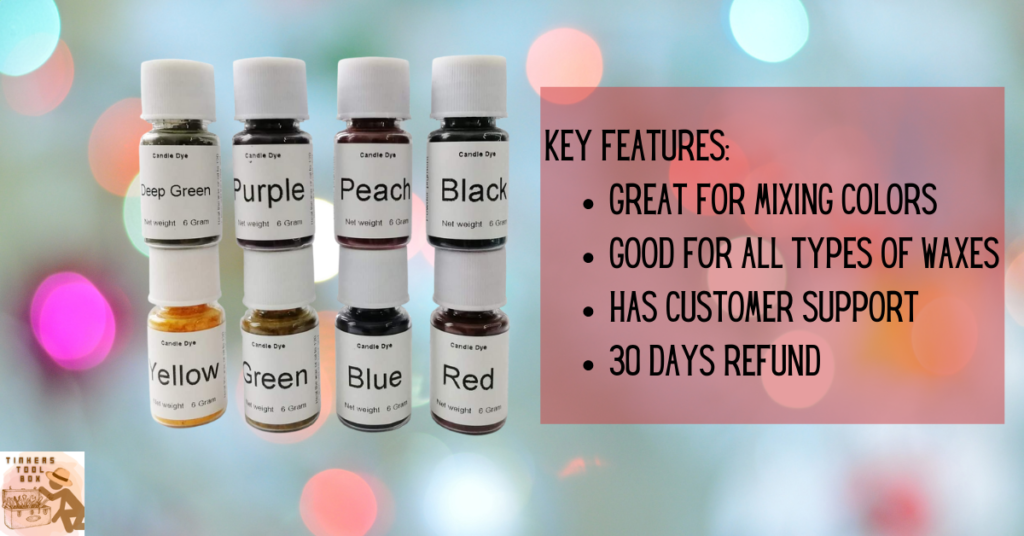
The Kingfinger Soy Candle Powder Dye comes in eight different colors for you to choose from; it also includes vibrant prime colors for you to mix and create whatever hue you want. The powder dye is super concentrated and will allow you to get strong, attention-grabbing colors with just a small amount.
It comes with six bottles that hold colored powder, and each bottle is 0.20 ounces. There are times when beeswax tends to be hard to color, but with the Kingfinger Soy Candle Powder Dye, you can see great results. In each bottle, you can make about 11 pounds of candles.
All you need to do is heat your chosen wax to 150 to 170 degrees Fahrenheit, and then you can add the color and stir until it melts. There are three primary colors available, which can be mixed to get more colors that you want.
It is the ideal candle dye that you can use to add beautiful colors to your candles. Now, there are two downsides to this powder dye. First, it only contains basic and primary colors. Also, the result of the pink powder is not as great as the other colors.
If you need any assistance, Kingfinger has a complete customer support line that is open 24 hours. They also have 30 days refund if you are not comfortable with the result of the powder dye. You can get the Kingfinger Soy Candle Powder Dye on Amazon for $16.99.
YRYM HT Liquid Candle Dye: Great for Soy Candles
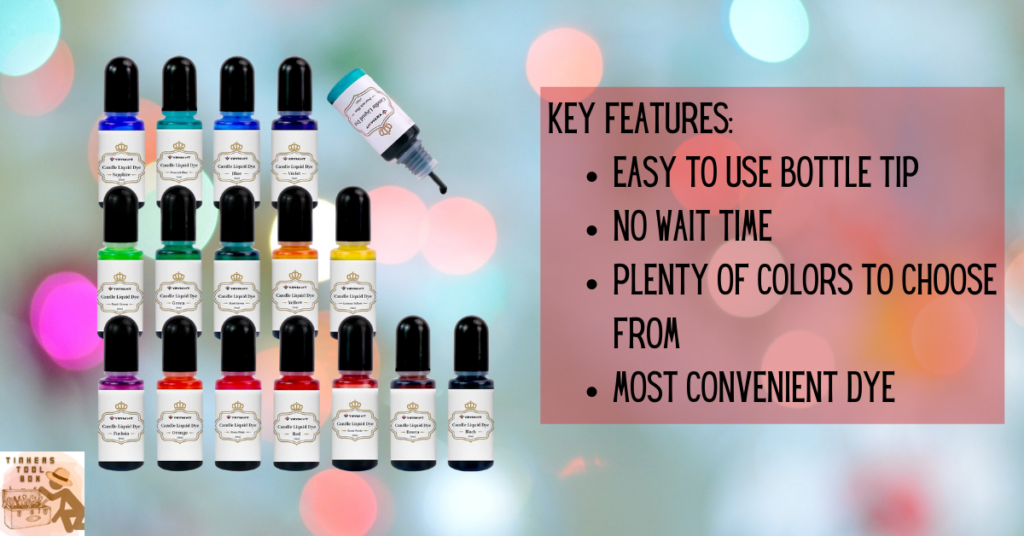
The YRYM HT Liquid Candle Dye has 16 different colors that include green, dark green, bean paste, and even rose pink. Each bottle comes in 10mL with a squeezable dropper that you don’t have to remove whenever you use them. This liquid dye is recommended to use with soy wax only, and they do not have a strong chemical odor like other liquid dyes.
You can have fun mixing these colors and try out your own unique colors. You can’t get this enjoyment with block or chip dyes since you don’t have to wait for it to melt to see the color that you will be getting. This liquid candle dye is safe and doesn’t contain any toxic substances.
It also will not produce gas after being mixed with wax or affect the smell of your candles. With this, you don’t need to worry about the smell mixing with your fragrance. Each bottle of candle dye can make 22 pounds of soy wax within a reasonable additional range.
The YRYM HT Liquid Candle Dye has a good dyeing effect and high color rendering, which can be evenly colored once you have stirred it gently. With all the colors readily available, you can let your imagination run wild with the different colors that you can do.
Now, the two downsides to the YRYM HT Liquid Candle Dye are it isn’t recommended for any other type of wax such as paraffin. It only works great with soy wax. You would also need to use plenty of products to get the strong color that you need since it is not concentrated like the other dyes on this list.
The YRYM HT Liquid Candle Dye is available on Amazon for $16.99.
GESD Wax Block Candle Dye: The Best Block Candle Dye You Can Use
When it comes to a wide range of colors, the GESD Wax Block Candle Dye offers just that. It comes with 12 bold colors that are perfect to color any type of wax. These dyes are non-toxic, don’t produce any air bubbles, and create intense, vibrant colors that will match the block’s color.
The best part about this block candle dye is that they don’t stain your skin and interfere with any fragrance oil that you may put in your candle. These are great, straightforward colors, and when they break up the blocks into smaller pieces, they melt faster and mix in better.
Each bottle of the GESD Wax Block Candle Dye contains 0.16 ounces of dyes. With these dyes, rest assured your candles will be made with plenty of bright and colorful colors.
All you need to do is melt your wax at a temperature from 140 to 230 degrees Fahrenheit. Then, mix the GESD Wax Block Candle Dye carefully for about two to three minutes. The richness of the color would depend on the amount of dye used in the candle.
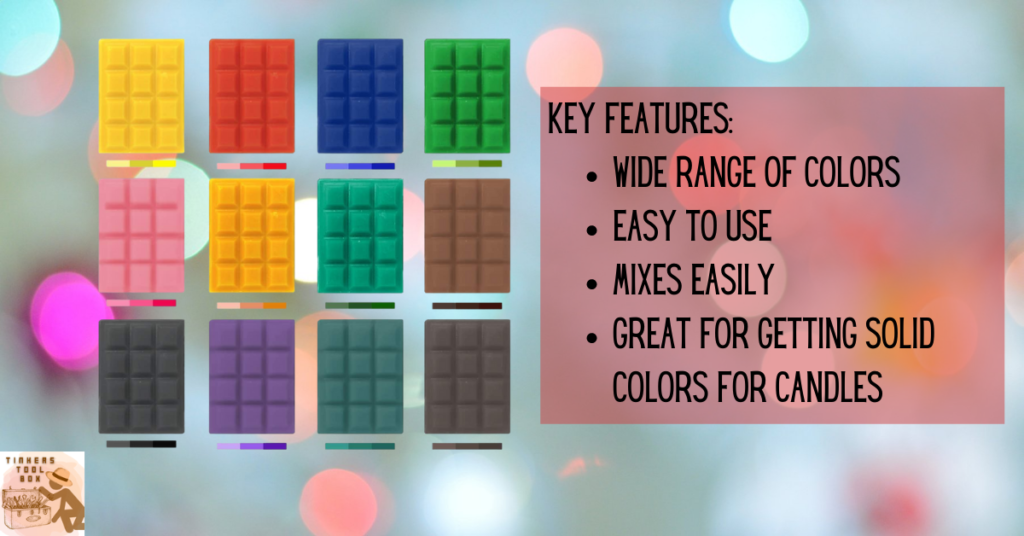
If you want a darker color, then you would have to use more dye. When you are melting the dye, it won’t be dissolved in clots, and the staining will be even. It also doesn’t flake or tarnish over time. It will let the process of candle-making turn out smooth and quick.
The GESD Wax Block Candle Dye is made with no pungent smell, non-toxic, animal-friendly, stain-free, safe to the skin, and gentle. Let’s say you have dyed something uncautiously; the color will be easy to wash away with hot water as well as it will not stain your skin or your clothes.
This block candle dye has ten years of OEM candle competency. They also have the most efficient technical support team that will provide service to you.
The two downsides to this block candle dyes are it looks much smaller than expected since it contains 60 grams. Also, you would need a large chunk of wax to get the high color saturation that you want for your candles.
The GESD Wax Block Candle Dye is available on Amazon for $19.85.
EricX Light Wax Candle Color Dye: Most Variety of Colors
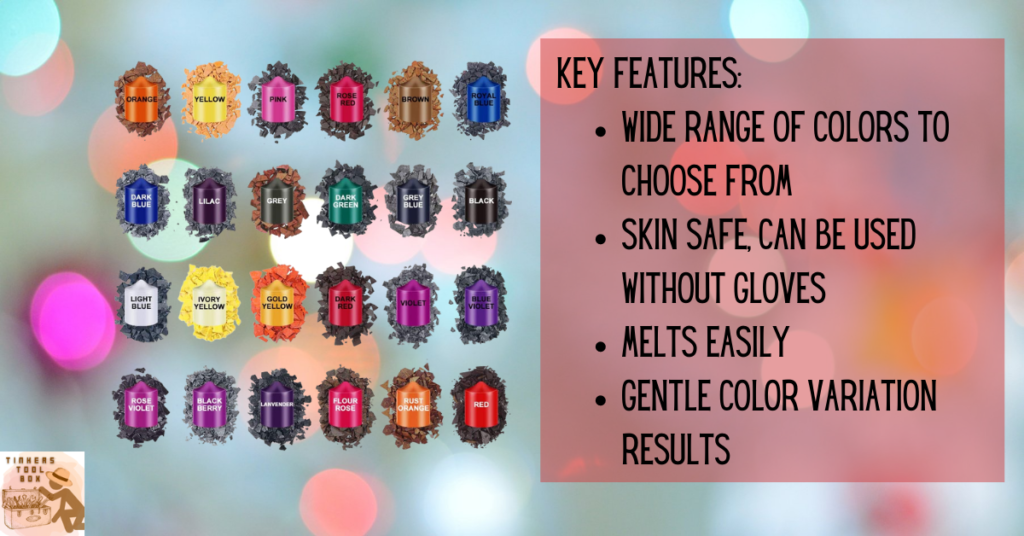
The EricX Light Wax Candle Color has a wide range of colors that you can choose from; to be exact, they come in 24 exciting colors in three-ounce bags. They are perfect for different types of wax to make your candles and easily melt as well as mix into your candle creations.
You only need to use about 0.02 ounces of dye chips to color your wax for your candle-making project. When using this, you will enjoy watching how each color chip from the packaging turns into gentle color variations. In one pound wax, you would need about 0.015 to 0.02 ounces of the EricX Light Wax Candle Color Dye.
These dyes are best dissolved at a temperature of 200 degrees Fahrenheit. Make sure that you mix them carefully for about two to three minutes so that the color can incorporate with the wax well.
This dye is also great for most wax such as paraffin, beeswax, palm wax, and soy wax. It is also non-toxic and safe to the skin when you use this type of dye.
Now, the downside to the EricX Light Wax Candle Color Dye is the packaging is a bit too plain, and there are some color flakes that settle in the bottom of your candle.
You can get the EricX Light Wax Candle Color Dye is available on Amazon for $11.99.
Types of Candle Dyes that You Can Buy
Before you go out and buy your candle dye, it is best to know the different types of candles that you can use. There are three different types of candle dyes that you can choose from such as dye chips, dye blocks, and liquid dye. Each of them has its own disadvantages and advantages when it comes to your candle-making projects.
Dye Chips: No Fuss When Coloring Your Candles
Dye chips are very convenient to use when it comes to dyeing your candles. They are simple to use because all you need is one dye chip for every 500 grams of wax. Having said this, the amount you will need would still depend on the desired shade of color. If you want to have more vibrant colors, it would be best to add more chips.
The only downside to the dye chips is that they are not as colorfast, and it takes quite a few minutes to reach the intense color you want for your candles.
Dye Blocks: Great for Soy, Palm, and Paraffin Wax
On the other hand, Dye blocks are very concentrated, which makes them great for soy wax, palm wax, and paraffin wax. Usually, the blocks are measured 5cm x 3cm, and you would need one dye block to color three kilograms of wax.
It will result in a medium shade, and like the dye chips, if you want a more vibrant color, best to add more dye blocks to your wax. Dye blocks are best to use for coloring larger volumes of wax.
The downside to dye blocks is the consistency when you are doing small batches. It can be hard to get the exact amount of dye each time you give your batch the same color each time.
Liquid Dye: Most Concentrated Form of Dye
Liquid candle dyes are considered to be the most concentrated form of coloring that you can use for coloring wax. It is very easy to use with paraffin wax, beeswax, soy wax, palm wax, and so much more. The usage for liquid dye is about three drops per 500 grams if you want a lighter shade.
For a darker and vibrant shade, about six drops per 500 grams will do. These dyes can be added at the start while your wax is melting or at the end just before you pour your wax into molds. It is also easily blendable.
Now, the downside to liquid dye is there are some products that smell terrible. Now, it won’t affect your fragrance, but they do have a strong smell by themselves. Liquid dye also can cause your wax to cool faster than normal, and adding too much can result in texture issues.
Lastly, they can be very messy to use, especially when you spill them. This may not be the best dye to use when you are doing candle-making projects with children.
Factors to Consider When Choosing a Candle Dye
There are different factors that you need to consider when it comes to choosing your candle dye for your candle-making projects. The following will talk about the different factors that you need to keep in mind when you are deciding what candle dyes you would use for your candle-making projects.
Pigment Vs. Dyes: Know the Difference
The very first thing that you need to keep in mind is the difference between pigments and dyes. Ignoring this knowledge can cause different problems during your candle-making projects.
A pigment is, at most times, an insoluble inorganic compound that doesn’t dissolve into a mixture. Instead, they blend in and sit in a suspended state when mixed with another product. It is important to candle-making since using pigment rather than dye can introduce particles that will end up clogging your wick.
Pigments will not only keep your wick from burning the wax properly, but they will also increase the risk of combustion. Pigmented-based products you should avoid using are crayons, titanium dioxide, and mica powder.
Now, mica powder is often marketed when it comes to candle dye, and while the mica powder can be used to color the outside of a candle, it is best to avoid using it to color the inside of the wax.
Dyes, on the other hand, are oil-soluble compounds, and they work perfectly for coloring candles. There are plenty of dyes that are made of aniline, which is a synthetic compound that has been used to make dyes for years.
Since dyes are oil-soluble, they emulsify with the wax and create an even coloring as well as a smooth burn. Make sure always to use dyes that are oil-soluble when you are making colored candles.
Know the Color Saturation of Your Dyes
Whenever you are using candle-making dyes, it is crucial to consider the level of color saturation you want. Different types of dyes can produce different levels of color saturation, so it is best to know what your end color goal would be when choosing the right dye product.
Most of the time, dye blocks and liquid dyes produce the most vibrant colors. Now, dye chips are better from achieving a pastel hue, and it varies greatly between brands, depending on what type of wax you are using.
Dye blocks work well with paraffin wax in large amounts, whereas dye chips color small amounts of wax well. Liquid dyes, on the other hand, are perfect for mixing and creating your own shades. Every time you use these products, you need to make sure to check the product to see what type of wax works well with it.
For you to create the color shade that you desire, there are a couple of tips that you should take note of. First, start with a small amount of color and add as you go if you want to create more intense colors. Also, test different types of dyes and waxes for you to know the type of result you prefer.
It is also best to learn about mixing colors and implement the color theory for you to gain experience. For you to test the final color, coat the back of a spoon with your wax and dip it into ice water. The hardened wax will show you the finished candle.
Lastly, follow the candle dye’s manufacturing directions at all times. These directions will give you the exact specifications for their product to help you reach particular colors.
Know How to Properly Store Dyes
Properly storing dyes is one thing to keep in mind since they are usually sensitive to UV light. When you are making vibrantly colored candles, it is best to keep them stored in a cool, dry place to maintain the color.
Another option that you can do is to purchase an additive called UV inhibitor. You will be mixing it during the creation process to help protect your candle color from fading over time under the sunlight. This would be very helpful when you are selling your candles, and the colors need to stay fresh.
Precautions When You Are Using Candle Dyes
Though candle dyes are considered to be safe, you will still need to take a few precautions when working with beautiful colors. First, you should always wear gloves to protect your skin from becoming stained by the dye colors. In some rare instances, you may have an allergic reaction to the dye product.
So it is best to be alert to any sensations that may indicate you have an allergic reaction, and when this happens, it is best to stop handling the product. Second, protect your workspace countertops from staining with some sort of covering. You can use a tarp, newspaper, or an old sheet or towel.
Third, never use insoluble pigment color on your candles since these materials increase the risk of combustion. Fourth, always avoid leaving dyes open or within reach of pets and children. Lastly, never use candle dyes for any other creative projects. They are only meant to be used in candle wax.
